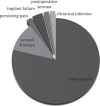Orthogeriatric Combined Management of Elderly Patients With Proximal Femoral Fracture: Results of a 1-Year Follow-Up
- PMID: 28540117
- PMCID: PMC5431412
- DOI: 10.1177/2151458517698536
Orthogeriatric Combined Management of Elderly Patients With Proximal Femoral Fracture: Results of a 1-Year Follow-Up
Abstract
Introduction: According to the expected demographical changes, the number of elderly trauma patients will increase exponentially over the next decades. Different models of an interdisciplinary orthogeriatric care have been developed. But there is only limited evaluation of their benefit without clear and evidence-based results. In 2011, we monitored the results of our orthogeriatric combined management by conducting a 1-year follow-up.
Methods: We treated 231 patients presenting a proximal femoral fracture on our orthogeriatric ward. We obtained the epidemiological data and the geriatric assessments from all these patients. One year after discharge, we sent them a written questionnaire. Primary end points were the mortality and the functional outcome, measured by Barthel score, the requirement of care, and the residential status.
Results: One hundred sixty-seven (72%) of the 231 patients completed the follow-up. The average age at admission was 81.5 years (70-99 years). The mortality rate was 2.4% during hospital stay and 31.4% after 1 year. The average Barthel score was 44 points at the time of admission, 55 points at discharge, and 72 points after 1 year. Forty-five percent of the patients were in requirement of care at the time of their admission. At the 1-year follow-up, 63% of the patients had some form of care, thus showing an increase of 18%. At the moment of the fracture, 77% of the patients were living in their own home and 23% in a nursing home. After 1 year, the surviving patients show nearly unchanged conditions (75% own home vs 25% nursing home). Eighty-six percent of the patients coming from their own home were able to continue living there independently.
Conclusion: The orthogeriatric care is successful in reducing the short-time mortality without showing any effect on 1-year mortality. But the surviving patients seem to benefit from an improved functional outcome.
Keywords: 1-year follow-up; fragility fractures; functional outcome; orthogeriatric comanagement; proximal femoral fracture.
Conflict of interest statement
Declaration of Conflicting Interests: The author(s) declared no potential conflicts of interest with respect to the research, authorship, and/or publication of this article.
Figures
References
-
- Roth T, Kammerlander C, Gosch M, Luger TJ, Blauth M. Outcome in geriatric fracture patients and how it can be improved. Osteoporos Int. 2010;21(supppl 4):S615–S619. - PubMed
-
- Becker C, Gebhard F, Fleischer S, et al. Prediction of mortality, mobility and admission to long-term care after hip fractures [in German]. Unfallchirurg. 2003;106(1):32–38. - PubMed
-
- Bliuc D, Nguyen ND, Milch VE, Nguyen TV, Eisman JA, Center JR. Mortality risk associated with low-trauma osteoporotic fracture and subsequent fracture in men and women. JAMA. 2009;301(5):513–521. - PubMed
-
- Muller-Mai CM, Schulze Raestrup US, Kostuj T, et al. One-year outcomes for proximal femoral fractures: posthospital analysis of mortality and care levels based on health insurance data [in German]. Unfallchirurg. 2015;118(9):780–794. - PubMed
LinkOut - more resources
Full Text Sources
Other Literature Sources





